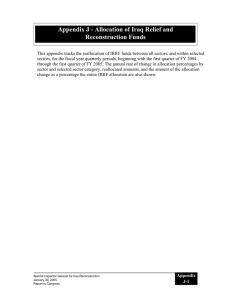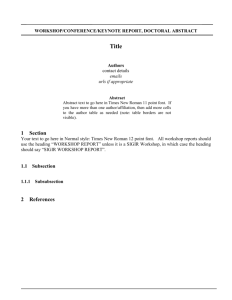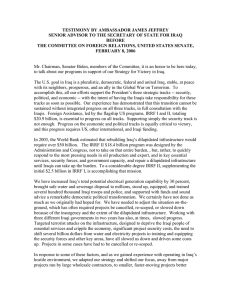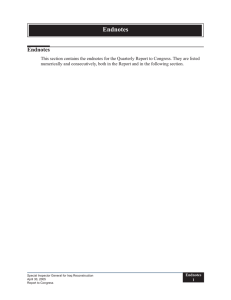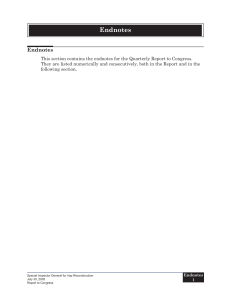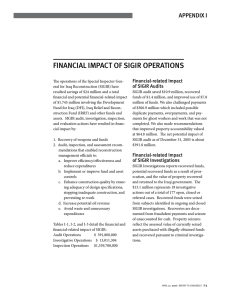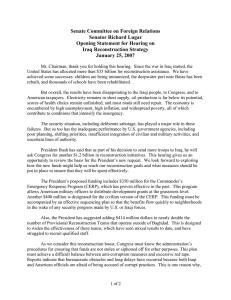Ultimately, the sustained recovery of Iraq can be accomplished only... Iraqis—soldiers, police, ministry leadership, regional officials, and the people
advertisement
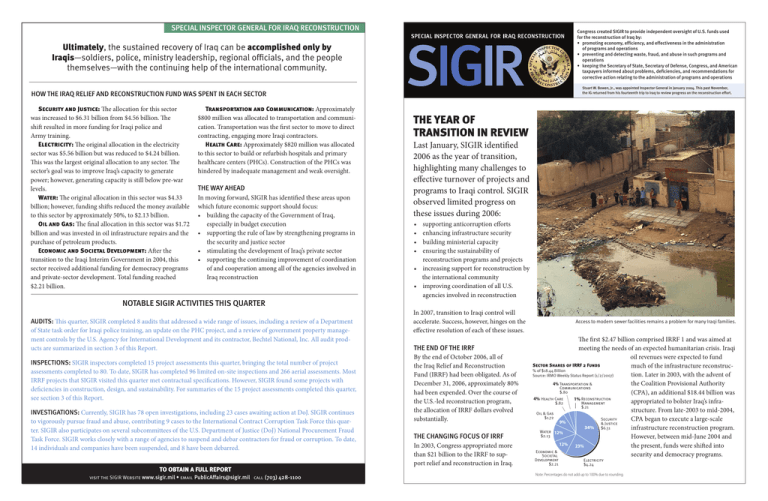
SPECIAL INSPECTOR GENERAL FOR IRAQ RECONSTRUCTION- SPECIAL INSPECTOR GENERAL FOR IRAQ RECONSTRUCTION Congress created SIGIR to provide independent oversight of U.S. funds used for the reconstruction of Iraq by: • promoting economy, efficiency, and effectiveness in the administration of programs and operations • preventing and detecting waste, fraud, and abuse in such programs and operations • keeping the Secretary of State, Secretary of Defense, Congress, and American taxpayers informed about problems, deficiencies, and recommendations for corrective action relating to the administration of programs and operations Ultimately, the sustained recovery of Iraq can be accomplished only by Iraqis—soldiers, police, ministry leadership, regional officials, and the people themselves—with the continuing help of the international community. Stuart W. Bowen, Jr., was appointed Inspector General in January 2004. This past November, the IG returned from his fourteenth trip to Iraq to review progress on the reconstruction effort. HOW the Iraq Relief and Reconstruction Fund WAS SPENT IN EACH SECTOR Security and Justice: The allocation for this sector was increased to $6.31 billion from $4.56 billion. The shift resulted in more funding for Iraqi police and Army training. Electricity: The original allocation in the electricity sector was $5.56 billion but was reduced to $4.24 billion. This was the largest original allocation to any sector. The sector’s goal was to improve Iraq’s capacity to generate power; however, generating capacity is still below pre-war levels. Water: The original allocation in this sector was $4.33 billion; however, funding shifts reduced the money available to this sector by approximately 50%, to $2.13 billion. Oil and Gas: The final allocation in this sector was $1.72 billion and was invested in oil infrastructure repairs and the purchase of petroleum products. Economic and Societal Development: After the transition to the Iraqi Interim Government in 2004, this sector received additional funding for democracy programs and private-sector development. Total funding reached $2.21 billion. Transportation and Communication: Approximately $800 million was allocated to transportation and communication. Transportation was the first sector to move to direct contracting, engaging more Iraqi contractors. Health Care: Approximately $820 million was allocated to this sector to build or refurbish hospitals and primary healthcare centers (PHCs). Construction of the PHCs was hindered by inadequate management and weak oversight. THE WAY AHEAD In moving forward, SIGIR has identified these areas upon which future economic support should focus: • building the capacity of the Government of Iraq, especially in budget execution • supporting the rule of law by strengthening programs in the security and justice sector • stimulating the development of Iraq’s private sector • supporting the continuing improvement of coordination of and cooperation among all of the agencies involved in Iraq reconstruction NOTABLE SIGIR ACTIVITIES THIS QUARTER AUDITS: This quarter, SIGIR completed 8 audits that addressed a wide range of issues, including a review of a Department of State task order for Iraqi police training, an update on the PHC project, and a review of government property management controls by the U.S. Agency for International Development and its contractor, Bechtel National, Inc. All audit products are summarized in section 3 of this Report. INSPECTIONS: SIGIR inspectors completed 15 project assessments this quarter, bringing the total number of project assessments completed to 80. To date, SIGIR has completed 96 limited on-site inspections and 266 aerial assessments. Most IRRF projects that SIGIR visited this quarter met contractual specifications. However, SIGIR found some projects with deficiencies in construction, design, and sustainability. For summaries of the 15 project assessments completed this quarter, see section 3 of this Report. INVESTIGATIONS: Currently, SIGIR has 78 open investigations, including 23 cases awaiting action at DoJ. SIGIR continues to vigorously pursue fraud and abuse, contributing 9 cases to the International Contract Corruption Task Force this quarter. SIGIR also participates on several subcommittees of the U.S. Department of Justice (DoJ) National Procurement Fraud Task Force. SIGIR works closely with a range of agencies to suspend and debar contractors for fraud or corruption. To date, 14 individuals and companies have been suspended, and 8 have been debarred. TO OBTAIN A FULL REPORT visit the SIGIR Website www.sigir.mil • email PublicAffairs@sigir.mil call (703) 428-1100 THE YEAR OF TRANSITION IN REVIEW Last January, SIGIR identified 2006 as the year of transition, highlighting many challenges to effective turnover of projects and programs to Iraqi control. SIGIR observed limited progress on these issues during 2006: •supporting anticorruption efforts •enhancing infrastructure security •building ministerial capacity •ensuring the sustainability of reconstruction programs and projects •increasing support for reconstruction by the international community •improving coordination of all U.S. agencies involved in reconstruction In 2007, transition to Iraqi control will accelerate. Success, however, hinges on the effective resolution of each of these issues. The End of THE IRRF By the end of October 2006, all of the Iraq Relief and Reconstruction Fund (IRRF) had been obligated. As of December 31, 2006, approximately 80% had been expended. Over the course of the U.S.-led reconstruction program, the allocation of IRRF dollars evolved substantially. THE CHANGING FOCUS OF IRRF In 2003, Congress appropriated more than $21 billion to the IRRF to support relief and reconstruction in Iraq. Access to modern sewer facilities remains a problem for many Iraqi families. The first $2.47 billion comprised IRRF 1 and was aimed at meeting the needs of an expected humanitarian crisis. Iraqi oil revenues were expected to fund Sector Shares of IRRF 2 Funds much of the infrastructure reconstruc% of $18.44 Billion tion. Later in 2003, with the advent of Source: IRMO Weekly Status Report (1/2/2007) 4% Transportation & the Coalition Provisional Authority Communications $.80 (CPA), an additional $18.44 billion was 4% Health Care 1% Reconstruction appropriated to bolster Iraq’s infra$.82 Management $.21 structure. From late-2003 to mid-2004, Oil & Gas $1.72 Security CPA began to execute a large-scale 9% & Justice 34% $6.31 infrastructure reconstruction program. Water 12% $2.13 However, between mid-June 2004 and 12% the present, funds were shifted into 23% Economic & security and democracy programs. Societal Development $2.21 Electricity $4.24 Note: Percentages do not add up to 100% due to rounding. SPECIAL INSPECTOR GENERAL FOR IRAQ RECONSTRUCTION- SPECIAL INSPECTOR GENERAL FOR IRAQ RECONSTRUCTION Congress created SIGIR to provide independent oversight of U.S. funds used for the reconstruction of Iraq by: • promoting economy, efficiency, and effectiveness in the administration of programs and operations • preventing and detecting waste, fraud, and abuse in such programs and operations • keeping the Secretary of State, Secretary of Defense, Congress, and American taxpayers informed about problems, deficiencies, and recommendations for corrective action relating to the administration of programs and operations Ultimately, the sustained recovery of Iraq can be accomplished only by Iraqis—soldiers, police, ministry leadership, regional officials, and the people themselves—with the continuing help of the international community. Stuart W. Bowen, Jr., was appointed Inspector General in January 2004. This past November, the IG returned from his fourteenth trip to Iraq to review progress on the reconstruction effort. HOW the Iraq Relief and Reconstruction Fund WAS SPENT IN EACH SECTOR Security and Justice: The allocation for this sector was increased to $6.31 billion from $4.56 billion. The shift resulted in more funding for Iraqi police and Army training. Electricity: The original allocation in the electricity sector was $5.56 billion but was reduced to $4.24 billion. This was the largest original allocation to any sector. The sector’s goal was to improve Iraq’s capacity to generate power; however, generating capacity is still below pre-war levels. Water: The original allocation in this sector was $4.33 billion; however, funding shifts reduced the money available to this sector by approximately 50%, to $2.13 billion. Oil and Gas: The final allocation in this sector was $1.72 billion and was invested in oil infrastructure repairs and the purchase of petroleum products. Economic and Societal Development: After the transition to the Iraqi Interim Government in 2004, this sector received additional funding for democracy programs and private-sector development. Total funding reached $2.21 billion. Transportation and Communication: Approximately $800 million was allocated to transportation and communication. Transportation was the first sector to move to direct contracting, engaging more Iraqi contractors. Health Care: Approximately $820 million was allocated to this sector to build or refurbish hospitals and primary healthcare centers (PHCs). Construction of the PHCs was hindered by inadequate management and weak oversight. THE WAY AHEAD In moving forward, SIGIR has identified these areas upon which future economic support should focus: • building the capacity of the Government of Iraq, especially in budget execution • supporting the rule of law by strengthening programs in the security and justice sector • stimulating the development of Iraq’s private sector • supporting the continuing improvement of coordination of and cooperation among all of the agencies involved in Iraq reconstruction NOTABLE SIGIR ACTIVITIES THIS QUARTER AUDITS: This quarter, SIGIR completed 8 audits that addressed a wide range of issues, including a review of a Department of State task order for Iraqi police training, an update on the PHC project, and a review of government property management controls by the U.S. Agency for International Development and its contractor, Bechtel National, Inc. All audit products are summarized in section 3 of this Report. INSPECTIONS: SIGIR inspectors completed 15 project assessments this quarter, bringing the total number of project assessments completed to 80. To date, SIGIR has completed 96 limited on-site inspections and 266 aerial assessments. Most IRRF projects that SIGIR visited this quarter met contractual specifications. However, SIGIR found some projects with deficiencies in construction, design, and sustainability. For summaries of the 15 project assessments completed this quarter, see section 3 of this Report. INVESTIGATIONS: Currently, SIGIR has 78 open investigations, including 23 cases awaiting action at DoJ. SIGIR continues to vigorously pursue fraud and abuse, contributing 9 cases to the International Contract Corruption Task Force this quarter. SIGIR also participates on several subcommittees of the U.S. Department of Justice (DoJ) National Procurement Fraud Task Force. SIGIR works closely with a range of agencies to suspend and debar contractors for fraud or corruption. To date, 14 individuals and companies have been suspended, and 8 have been debarred. TO OBTAIN A FULL REPORT visit the SIGIR Website www.sigir.mil • email PublicAffairs@sigir.mil call (703) 428-1100 THE YEAR OF TRANSITION IN REVIEW Last January, SIGIR identified 2006 as the year of transition, highlighting many challenges to effective turnover of projects and programs to Iraqi control. SIGIR observed limited progress on these issues during 2006: •supporting anticorruption efforts •enhancing infrastructure security •building ministerial capacity •ensuring the sustainability of reconstruction programs and projects •increasing support for reconstruction by the international community •improving coordination of all U.S. agencies involved in reconstruction In 2007, transition to Iraqi control will accelerate. Success, however, hinges on the effective resolution of each of these issues. The End of THE IRRF By the end of October 2006, all of the Iraq Relief and Reconstruction Fund (IRRF) had been obligated. As of December 31, 2006, approximately 80% had been expended. Over the course of the U.S.-led reconstruction program, the allocation of IRRF dollars evolved substantially. THE CHANGING FOCUS OF IRRF In 2003, Congress appropriated more than $21 billion to the IRRF to support relief and reconstruction in Iraq. Access to modern sewer facilities remains a problem for many Iraqi families. The first $2.47 billion comprised IRRF 1 and was aimed at meeting the needs of an expected humanitarian crisis. Iraqi oil revenues were expected to fund Sector Shares of IRRF 2 Funds much of the infrastructure reconstruc% of $18.44 Billion tion. Later in 2003, with the advent of Source: IRMO Weekly Status Report (1/2/2007) 4% Transportation & the Coalition Provisional Authority Communications $.80 (CPA), an additional $18.44 billion was 4% Health Care 1% Reconstruction appropriated to bolster Iraq’s infra$.82 Management $.21 structure. From late-2003 to mid-2004, Oil & Gas $1.72 Security CPA began to execute a large-scale 9% & Justice 34% $6.31 infrastructure reconstruction program. Water 12% $2.13 However, between mid-June 2004 and 12% the present, funds were shifted into 23% Economic & security and democracy programs. Societal Development $2.21 Electricity $4.24 Note: Percentages do not add up to 100% due to rounding.
